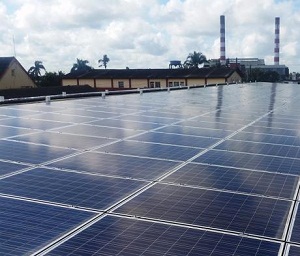 Among its merits – which are many according to experts, evidenced by the numerous prizes and recognitions won at fairs and expositions – is the fact that it is produced entirely with solar energy.
Among its merits – which are many according to experts, evidenced by the numerous prizes and recognitions won at fairs and expositions – is the fact that it is produced entirely with solar energy.
In May of 2016, taking advantage of the nature of the distillery’s roof, a solar photovoltaic park was installed, composed of 2,752 panels, capable of generating more than 900 megawatts annually, according to Carlos Rubén Armas Díaz, plant director.
The distillery is a pioneer in the use of solar energy in Cuba, he added, and the strategy is linked to steps being taken to prevent, mitigate, and eliminate the negative environmental impact of the rum production process.
Of all energy produced by the solar panels, the plant consumes only 38%, and the rest, 62%, is delivered to the national power grid (SEN), allowing for important savings and greater efficiency at the Agustín Rodríguez Mena distillery, Armas noted.
Some facts provided by the director confirm this. Through the first four months of the year, more than 6,000 pesos have been earned supplying electricity to the national grid, while more than 175,216 pesos have been saved with reduced energy consumption since the project was launched two years ago, he reported.
Other elements that reveal the significance of this project include the fact that the release of 19,142 tons of carbon dioxide into the atmosphere has been avoided, since the burning of 473 tons of crude oil was not needed, thus also saving the national economy 279,000 pesos. Plus, loss of energy in transmission has also been eliminated, according to an explanation provided by electrical engineer Gustavo Otero Barroso, who is in charge of the photovoltaic park.
Constructed at a cost of 1.8 million euros, the investment will be recovered within a period of 15 years, and among the solar park’s advantages is the fact that little staff is needed for maintenance and operation, since just two people are required to handle its daily cleaning and functioning, Otero explained.
Another indication of the utility of this technology is its ability to withstand extreme weather phenomena, since it is designed to tolerate winds of up to 240 kilometers an hour – a strength proven during Hurricane Irma, when all panels were ready for operation just one day after the storm.
Given results obtained in the production of rum with the use of renewable energy and appropriate waste management, as well as studies conducted on health risks and vulnerabilities in the event of natural disasters, the Central Rum Distillery was awarded the Provincial Environmental Prize, as well as a number of quality prizes, including the 2007 international recognition granted by the United Nations Industrial Development Organization to companies making outstanding efforts to promote cleaner production.
SPECIFICATIONS
-The name of the renowned Cubay brand is of Arawak origin, and emerged from the recovery of the closest rum making tradition in the region, coming from the San Lino distillery in Cienfuegos, where liquor was produced, and El Infierno, located in Sagua la Grande. The experience of these rum makers and the spirits stored in their warehouses were brought to the George Washington sugar mill, in Santo Domingo.
-According to the explanation provided by industrial engineer Carlos Rubén Armas Díaz, director of the Central Rum Distillery, Cubay was first produced in 1996, when the Carta Blanca and Cubay Añejo rums were born, a line that has grown with new types, including Carta Blanca Extra Viejo, Extra Añejo 1870, Elixir 33, and Remedios 500, among others.
-Distinguished as a rum with singular characteristics, very different from those produced in the country’s eastern region, specifically Santiago, which is somewhat sweet, as well as that distilled in the west, especially Havana Club, which is drier, Cubay is an intermediate between the two schools, according to master rum maker César Augusto Martí Marcelo.
-With a production of 400,000 boxes a year, Cubay is available throughout the national market and served at major tourist resorts, in addition to selling well in various nations in Central America, the Caribbean, and Europe, in countries like the Netherlands, Germany, Spain, and Italy, which saw a 40% increase last year.
(Granma)